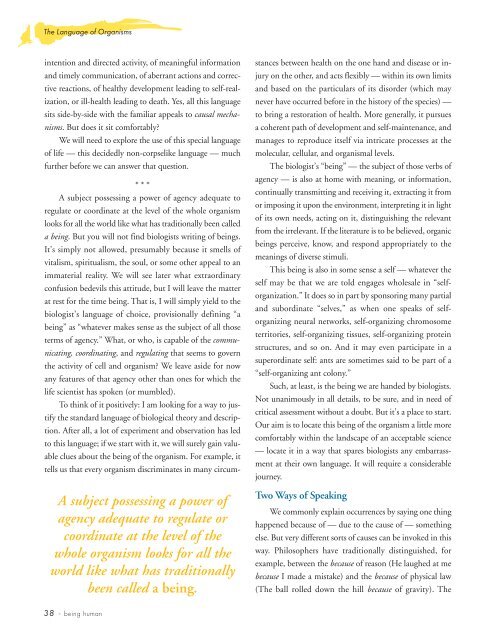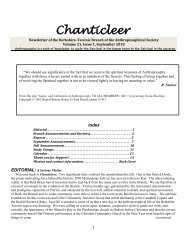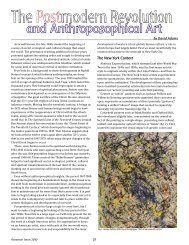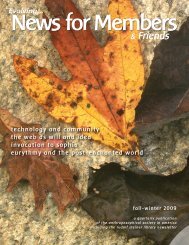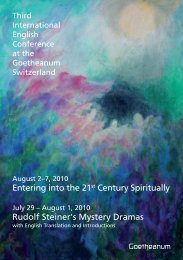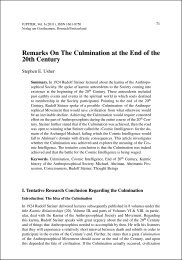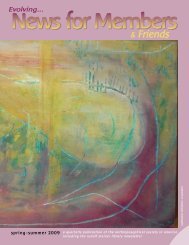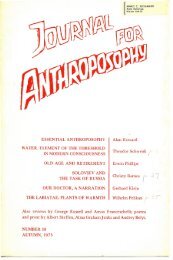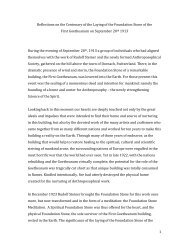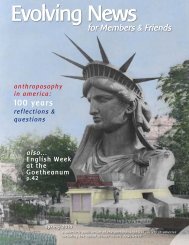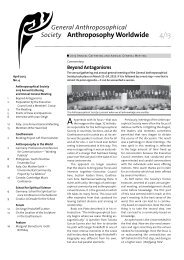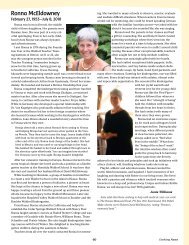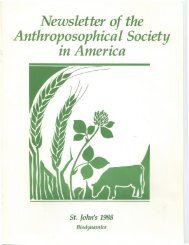Rudolf Steiner's Vision for the Future - Anthroposophical Society in ...
Rudolf Steiner's Vision for the Future - Anthroposophical Society in ...
Rudolf Steiner's Vision for the Future - Anthroposophical Society in ...
You also want an ePaper? Increase the reach of your titles
YUMPU automatically turns print PDFs into web optimized ePapers that Google loves.
XXXXXXX The Language of Organisms<br />
<strong>in</strong>tention and directed activity, of mean<strong>in</strong>gful <strong>in</strong><strong>for</strong>mation<br />
and timely communication, of aberrant actions and corrective<br />
reactions, of healthy development lead<strong>in</strong>g to self-realization,<br />
or ill-health lead<strong>in</strong>g to death. Yes, all this language<br />
sits side-by-side with <strong>the</strong> familiar appeals to causal mechanisms.<br />
But does it sit com<strong>for</strong>tably?<br />
We will need to explore <strong>the</strong> use of this special language<br />
of life — this decidedly non-corpselike language — much<br />
fur<strong>the</strong>r be<strong>for</strong>e we can answer that question.<br />
* * *<br />
A subject possess<strong>in</strong>g a power of agency adequate to<br />
regulate or coord<strong>in</strong>ate at <strong>the</strong> level of <strong>the</strong> whole organism<br />
looks <strong>for</strong> all <strong>the</strong> world like what has traditionally been called<br />
a be<strong>in</strong>g. But you will not f<strong>in</strong>d biologists writ<strong>in</strong>g of be<strong>in</strong>gs.<br />
It’s simply not allowed, presumably because it smells of<br />
vitalism, spiritualism, <strong>the</strong> soul, or some o<strong>the</strong>r appeal to an<br />
immaterial reality. We will see later what extraord<strong>in</strong>ary<br />
confusion bedevils this attitude, but I will leave <strong>the</strong> matter<br />
at rest <strong>for</strong> <strong>the</strong> time be<strong>in</strong>g. That is, I will simply yield to <strong>the</strong><br />
biologist’s language of choice, provisionally def<strong>in</strong><strong>in</strong>g “a<br />
be<strong>in</strong>g” as “whatever makes sense as <strong>the</strong> subject of all those<br />
terms of agency.” What, or who, is capable of <strong>the</strong> communicat<strong>in</strong>g,<br />
coord<strong>in</strong>at<strong>in</strong>g, and regulat<strong>in</strong>g that seems to govern<br />
<strong>the</strong> activity of cell and organism? We leave aside <strong>for</strong> now<br />
any features of that agency o<strong>the</strong>r than ones <strong>for</strong> which <strong>the</strong><br />
life scientist has spoken (or mumbled).<br />
To th<strong>in</strong>k of it positively: I am look<strong>in</strong>g <strong>for</strong> a way to justify<br />
<strong>the</strong> standard language of biological <strong>the</strong>ory and description.<br />
After all, a lot of experiment and observation has led<br />
to this language; if we start with it, we will surely ga<strong>in</strong> valuable<br />
clues about <strong>the</strong> be<strong>in</strong>g of <strong>the</strong> organism. For example, it<br />
tells us that every organism discrim<strong>in</strong>ates <strong>in</strong> many circum-<br />
A subject possess<strong>in</strong>g a power of<br />
agency adequate to regulate or<br />
coord<strong>in</strong>ate at <strong>the</strong> level of <strong>the</strong><br />
whole organism looks <strong>for</strong> all <strong>the</strong><br />
world like what has traditionally<br />
been called a be<strong>in</strong>g.<br />
38 • be<strong>in</strong>g human<br />
stances between health on <strong>the</strong> one hand and disease or <strong>in</strong>jury<br />
on <strong>the</strong> o<strong>the</strong>r, and acts flexibly — with<strong>in</strong> its own limits<br />
and based on <strong>the</strong> particulars of its disorder (which may<br />
never have occurred be<strong>for</strong>e <strong>in</strong> <strong>the</strong> history of <strong>the</strong> species) —<br />
to br<strong>in</strong>g a restoration of health. More generally, it pursues<br />
a coherent path of development and self-ma<strong>in</strong>tenance, and<br />
manages to reproduce itself via <strong>in</strong>tricate processes at <strong>the</strong><br />
molecular, cellular, and organismal levels.<br />
The biologist’s “be<strong>in</strong>g” — <strong>the</strong> subject of those verbs of<br />
agency — is also at home with mean<strong>in</strong>g, or <strong>in</strong><strong>for</strong>mation,<br />
cont<strong>in</strong>ually transmitt<strong>in</strong>g and receiv<strong>in</strong>g it, extract<strong>in</strong>g it from<br />
or impos<strong>in</strong>g it upon <strong>the</strong> environment, <strong>in</strong>terpret<strong>in</strong>g it <strong>in</strong> light<br />
of its own needs, act<strong>in</strong>g on it, dist<strong>in</strong>guish<strong>in</strong>g <strong>the</strong> relevant<br />
from <strong>the</strong> irrelevant. If <strong>the</strong> literature is to be believed, organic<br />
be<strong>in</strong>gs perceive, know, and respond appropriately to <strong>the</strong><br />
mean<strong>in</strong>gs of diverse stimuli.<br />
This be<strong>in</strong>g is also <strong>in</strong> some sense a self — whatever <strong>the</strong><br />
self may be that we are told engages wholesale <strong>in</strong> “sel<strong>for</strong>ganization.”<br />
It does so <strong>in</strong> part by sponsor<strong>in</strong>g many partial<br />
and subord<strong>in</strong>ate “selves,” as when one speaks of sel<strong>for</strong>ganiz<strong>in</strong>g<br />
neural networks, self-organiz<strong>in</strong>g chromosome<br />
territories, self-organiz<strong>in</strong>g tissues, self-organiz<strong>in</strong>g prote<strong>in</strong><br />
structures, and so on. And it may even participate <strong>in</strong> a<br />
superord<strong>in</strong>ate self: ants are sometimes said to be part of a<br />
“self-organiz<strong>in</strong>g ant colony.”<br />
Such, at least, is <strong>the</strong> be<strong>in</strong>g we are handed by biologists.<br />
Not unanimously <strong>in</strong> all details, to be sure, and <strong>in</strong> need of<br />
critical assessment without a doubt. But it’s a place to start.<br />
Our aim is to locate this be<strong>in</strong>g of <strong>the</strong> organism a little more<br />
com<strong>for</strong>tably with<strong>in</strong> <strong>the</strong> landscape of an acceptable science<br />
— locate it <strong>in</strong> a way that spares biologists any embarrassment<br />
at <strong>the</strong>ir own language. It will require a considerable<br />
journey.<br />
Two Ways of Speak<strong>in</strong>g<br />
We commonly expla<strong>in</strong> occurrences by say<strong>in</strong>g one th<strong>in</strong>g<br />
happened because of — due to <strong>the</strong> cause of — someth<strong>in</strong>g<br />
else. But very different sorts of causes can be <strong>in</strong>voked <strong>in</strong> this<br />
way. Philosophers have traditionally dist<strong>in</strong>guished, <strong>for</strong><br />
example, between <strong>the</strong> because of reason (He laughed at me<br />
because I made a mistake) and <strong>the</strong> because of physical law<br />
(The ball rolled down <strong>the</strong> hill because of gravity). The


